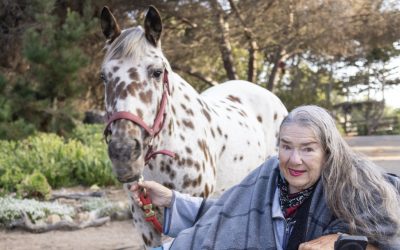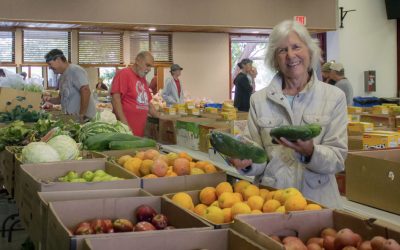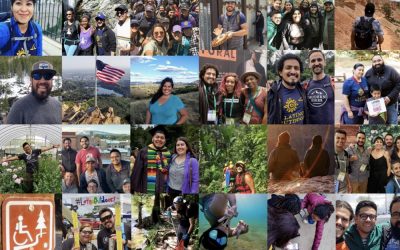Sullie, an aging gull, is distressed and angry about the trash left by people on the beach. Sullie’s granddaughter was permanently crippled after her entanglement in plastic waste— or so goes the story, “Sullie Saves the Sea,” a children’s book by ocean activist Goffinet McClaren. McClaren is not local, but the story she wrote is both universal and very local. As a matter of fact, during the last Coastal Cleanup Day in SLO County, volunteers removed 6,444 pounds of trash from our beaches and creeks, according to EcoSlo, the SLO County coordinator under the auspices of the California Coastal Commission.
On Saturday, Sept. 16, volunteers will choose between 31 regional sites set for cleanup. From Hearst State Beach to Oceano Dunes, and local lakes and watersheds to include Lopez Lake, Oso Flaco Lake, Santa Margarita Lake, Arroyo Grande Creek, and West Cuesta Ridge trailhead in Santa Margarita, over a thousand volunteers will coat themselves in sunscreen, tote buckets held by gloved hands, and pick up trash before it goes to sea. Coastal Cleanup Day is worldwide and the “the largest volunteer event on the planet,” boasts the Ocean Conservancy. Worldwide, about 12 million people volunteer for this one-day event.
Last year I observed the cleanup along the 4-mile stretch of Estero Bluffs State Park, under the guidance of the Cayucos Land Conservancy (CLC) with Cayucos resident Mary Bettencourt taking the lead. The cleanup literally rolled into high gear when 5th District County Supervisor Bruce Gibson hauled in an old tire just minutes after he began his trash hunt. But he sparked a gasp of horror by the volunteers when he produced several exploded remains of fireworks he found in the dry brush.
About 26 volunteers collected an array of waste, from tiny pieces of plastic to oversized sleeping bags. “Everyone was enthusiastic, especially the students from the Templeton High School Ecology Club,” Bettencourt said. “The volunteers were surprised at the amount of small plastic collected—the kind that chokes birds, including straws and lids,” Bettencourt added.
On Saturday, Sept. 16, volunteers will choose between 31 regional sites set for cleanup. From Hearst State Beach to Oceano Dunes, and local lakes and watersheds to include Lopez Lake, Oso Flaco Lake, Santa Margarita Lake, Arroyo Grande Creek, and West Cuesta Ridge trailhead in Santa Margarita, over a thousand volunteers will coat themselves in sunscreen, tote buckets held by gloved hands, and pick up trash before it goes to sea. Coastal Cleanup Day is worldwide and the “the largest volunteer event on the planet,” boasts the Ocean Conservancy. Worldwide, about 12 million people volunteer for this one-day event.
Last year I observed the cleanup along the 4-mile stretch of Estero Bluffs State Park, under the guidance of the Cayucos Land Conservancy (CLC) with Cayucos resident Mary Bettencourt taking the lead. The cleanup literally rolled into high gear when 5th District County Supervisor Bruce Gibson hauled in an old tire just minutes after he began his trash hunt. But he sparked a gasp of horror by the volunteers when he produced several exploded remains of fireworks he found in the dry brush.
About 26 volunteers collected an array of waste, from tiny pieces of plastic to oversized sleeping bags. “Everyone was enthusiastic, especially the students from the Templeton High School Ecology Club,” Bettencourt said. “The volunteers were surprised at the amount of small plastic collected—the kind that chokes birds, including straws and lids,” Bettencourt added.
But the most enthusiastic from my perspective were CLC members, Phil Kiesewetter and Larry Fishman. Armed with buckets and trash grabbers, they aggressively scoured the bluff grasslands like safari hunters. Only this time they hunted debris that would eventually wind up in the ocean and become part of the global pollution that endangers and entangles marine life and impacts human health and safety. “Marine debris entanglements have been documented for more than 275 species of animals, including 46% of all species of marine mammals,” as stated by the California Coastal Commission. Plus 245 different species “have been found to have ingested marine debris.” And for humans, the Coastal Commission notes, “Nails, glass, and syringes on the beach can cause physical harm to beachgoers. Additionally, trash in our waterways increases the amount of pathogens and chemicals, impacting water quality.”
Kieswetter and Fishman bagged a few trophies including a plastic irrigation line, and large plastic bags.
The Cayucos Land Conservancy (CLC) has a historical attachment to the Estero Bluff. CLC is “…committed to the enduring preservation of the rural greenbelt that surrounds Cayucos,” according to CLC’s website, Preservation of history and open space is the main goal of CLC. Land conservancies typically work with landowners to protect and conserve land for its natural, recreational, scenic, historic, or productive value. The Estero Bluffs are a special part of the Central Coast. Several endangered species inhabit the area, including the snowy plover. In the early 1990s zoning for development that included a 250-room hotel and 65 homes, on the bluffs was approved. CLC challenged the zoning. Now the four-mile stretch of coastline is part of the state parks system.
While scenic and spectacular, the bluffs accumulate debris from trash blowing out from the beds of passing trucks, people who find the unlit bit of highway a convenient dumping ground for old tires and an assortment of trash that was collected last year, like worn sleeping bags and, of course, the perennial plastic water bottle. On the positive side, Bettencourt said that less single-use plastic bags are now evident during SLO County coastal clean-up efforts.
The top five items of trash picked up throughout SLO County in 2017, according to EcoSlo were:
The Cayucos Land Conservancy (CLC) has a historical attachment to the Estero Bluff. CLC is “…committed to the enduring preservation of the rural greenbelt that surrounds Cayucos,” according to CLC’s website, Preservation of history and open space is the main goal of CLC. Land conservancies typically work with landowners to protect and conserve land for its natural, recreational, scenic, historic, or productive value. The Estero Bluffs are a special part of the Central Coast. Several endangered species inhabit the area, including the snowy plover. In the early 1990s zoning for development that included a 250-room hotel and 65 homes, on the bluffs was approved. CLC challenged the zoning. Now the four-mile stretch of coastline is part of the state parks system.
While scenic and spectacular, the bluffs accumulate debris from trash blowing out from the beds of passing trucks, people who find the unlit bit of highway a convenient dumping ground for old tires and an assortment of trash that was collected last year, like worn sleeping bags and, of course, the perennial plastic water bottle. On the positive side, Bettencourt said that less single-use plastic bags are now evident during SLO County coastal clean-up efforts.
The top five items of trash picked up throughout SLO County in 2017, according to EcoSlo were:
- 14,724 cigarette butts
- 8,631 plastic pieces
- 5,108 food wrappers
- 3133 glass pieces
- 2,504 plastic bottle caps
The California Coastal Commission has captained the cleanup for 33 years. From 1985 through 2016, 23,054,067 pounds of trash and recyclables were removed and properly disposed or recycled by 1,437, 549 volunteers, the commission reports.
The fictional marine debris battling gull, Sullie, forms a Secret Society of shorebirds that take on the task of teaching humans about leaving all sorts of litter on the beach. They mourn the loss of their pal, Stub, a dolphin that choked to death from a plastic toy that washed into the sea; and they skirmish to save Tatoosh Turtle, a 30-year- old sea turtle sick and near death from ingesting plastic bags that floated into Tatoosh’s habitat. Sullie completes his mission to educate humans about the multitude of debris commonly found during beach cleanups, and like the over 1,000 volunteers on our local beaches on Coastal Cleanup Day, takes a relaxing rest on a beautiful beach.
Coastal Cleanup Day is a perfect time for family and friends to form their own secret society against marine debris by picking a county cleanup site on Saturday, September 16, between 9 a.m. and noon. To me, a group picnic and to rest on perfectly cleaned beaches afterward, is a Central Coast ideal and gift.
To learn more, visit the EcoSlo website or contact EcoSlo at 805-544-1777 or email info@ecoslo.org.
The fictional marine debris battling gull, Sullie, forms a Secret Society of shorebirds that take on the task of teaching humans about leaving all sorts of litter on the beach. They mourn the loss of their pal, Stub, a dolphin that choked to death from a plastic toy that washed into the sea; and they skirmish to save Tatoosh Turtle, a 30-year- old sea turtle sick and near death from ingesting plastic bags that floated into Tatoosh’s habitat. Sullie completes his mission to educate humans about the multitude of debris commonly found during beach cleanups, and like the over 1,000 volunteers on our local beaches on Coastal Cleanup Day, takes a relaxing rest on a beautiful beach.
Coastal Cleanup Day is a perfect time for family and friends to form their own secret society against marine debris by picking a county cleanup site on Saturday, September 16, between 9 a.m. and noon. To me, a group picnic and to rest on perfectly cleaned beaches afterward, is a Central Coast ideal and gift.
To learn more, visit the EcoSlo website or contact EcoSlo at 805-544-1777 or email info@ecoslo.org.




